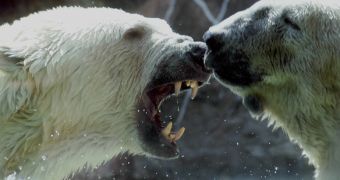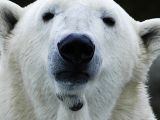Arctic ice is at a second lowest level this year, further limiting the natural habitat of the polar bears, which hugely affects their behavior as they are now prone to drowning and starving.
As we've recently shown, Arctic ice levels are in a constant free fall, as according to Walt Meier, a research scientist from the National Snow and Ice Data Center in Boulder, Colorado, "We did pick up little bit from last year, but this is over 30 percent below what used to be normal." The loss of ice during spring and summer is recovered in autumn and especially during the winter season, when Arctic ice normally gets to be 1 m (3 ft) to 3 m (9 ft) thick. But the last 50 years' global warming phenomenon, accompanied by its greenhouse effect – mainly caused by industrial businesses and pollution – has had an alarming impact on ice levels.
"It is the second lowest on record. [...] If anything, it is reinforcing the long-term trend. We are still losing the ice cover at a rate of 10 percent per decade now, and that is quite an increase from five years ago," showed Meier. "We are still heading toward an ice cover that is going to melt completely in the summertime in the Arctic," he added. Merely 30 years back, 7 million square km (2.5 million square miles) of ice were still standing tall in the Arctic region, but this has now been reduced by nearly 40%. In order for us to make a better idea of the proportions of the disaster, the researcher resorted to a vivid comparison: "Seven million square kilometers roughly corresponds to an area of the lower 48 United States. So back in the early 1980s, the lower 48 states would be covered in sea ice in the summer. Now we've essentially lost sea ice east of the Mississippi River and even beyond."
This is, in short, the evolution of the polar bears' habitat. As humans could hardly manage to adapt and survive to such harsh conditions and environment changes, neither can bears. They rely on ice in order to gain access to their favorite food, seals. When the floes retreat to the north, polar bears must follow the ice, sometimes for hundreds of miles, in order to keep track of their prey. Kassie Siegel, staff attorney for the Center for Biological Diversity explains: "The Arctic sea ice melt is a disaster for the polar bears. They are dependent on the Arctic sea ice for all of their essential behaviors, and as the ice melts and global warming transforms the Arctic, polar bears are starving, drowning, even resorting to cannibalism because they don't have access to their usual food sources."
This should not come as a surprise, since even humans resort to such ultimate techniques in order to stay alive, as described in a previous article. Recent years yielded an increased number of reports of polar bears becoming aggressive and even killing and eating each other. Such a documented incident happened in 2004 in the northern part of Alaska, when a male polar bear entered the den of a female and killed it. Sixty percent of the polar bears live in Canada (12.000-15.000 specimens), out of which 22% have gone extinct due to human hunting and the decreasing habitat.
This May, the U.S. Department of Interior labeled this bear species as "threatened" in the Endangered Species Act. Dirk Kempthorne, U.S. Interior Secretary declared in a press conference related to the subject that "Loss of sea ice threatens and will likely continue to threaten polar bear habitat. This loss of habitat puts polar bears at risk of becoming endangered in the foreseeable future, the standard established by the ESA for designating a threatened species."

 14 DAY TRIAL //
14 DAY TRIAL // 
